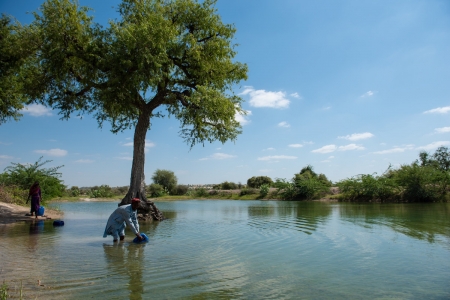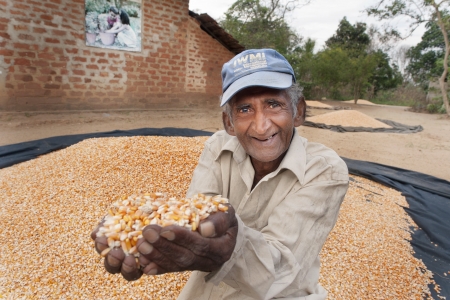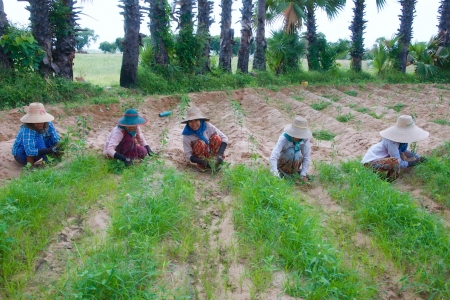“People who look at polders now straightaway say it’s bad because of their current state of disrepair. This is happening because of environmental degradation exacerbated by lack of maintenance. But you haven’t seen my boyhood or my father’s boyhood and how things have changed! Without polders the coastal zone is a dangerous place for communities to reside in. Polders have helped in lifting the socio-economic condition of people there. Without polders, if I had survived, my only options would have been to be a fisherman or a farmer.”
– Manoranjan Kumar Mondal, Scientist, IRRI
These were the remarks of a passionate scientist who grew up in the polders (low-lying land enclosed by embankments) of southern Bangladesh at the recent CGIAR Challenge Program on Water and Food (CPWF) conference on revitalizing the Ganges coastal zone. The question of whether polders have done more damage than good was raised by participants multiple times during the conference.
 Voices from the field: citizens from the polder zone speak about their issues and experiences. Photo: Khaled Sarkar
Voices from the field: citizens from the polder zone speak about their issues and experiences. Photo: Khaled SarkarThe coastal zone of Bangladesh is characterized by a vast and dense network of rivers and smaller tributaries crisscrossing the landscape, with most land less than five meters above sea level. The coastal polders of Bangladesh are densely populated, home to around 8 million people. Already prone to natural events such as cyclones, sea level rise, floods and drought, the inevitable climate change is likely to bring even more vulnerability to the region.
The polder boom
To make the land more productive the Government of Bangladesh, with the help of donors, constructed 139 large-scale polders in the 1960’s and 1970’s. The polder zone occupies an area of about 1.2 million hectares. It has also doubled as a shield against extreme climatic events, protecting the communities living within them.
The polders had an immediate and positive effect on agricultural production, which increased tremendously during the initial decades. Infrastructure enabled greater access to markets for goods. People in the polders experienced a boost in income and standard of living.
“I remember the cyclone that struck in the 1970s. In many places polders still weren’t built. Thousands died in that storm, I am 100% sure that polders would have saved them. After that storm many people who were living outside of the polders moved inside them. Many things have changed.”
- Abdul Wahab Munshi, President, Water Management Association, Polder 43/2F, Angulkata
However, over a period of time sedimentation and reduced river flows started spelling trouble for the polders. This was compounded by a lack of maintenance of polder infrastructure and mismanaged operation of the polder sluice gates, which allowed for the intake and drainage of water for farming purposes. Agricultural productivity flat lined and community conflicts over water management as well as donor intervention in the form of major polder maintenance became commonplace.
“Earlier rivers outside the polders were not silted and the canals within the embankments used to be deep. Now, both the canals and river beds have silted up leading to congestion and reduced flows. The water doesn’t go as quickly through the canals as it did earlier nor does it come as quickly into the canal.”
- Monoranjan Mandal - Chairman of Union Batiaghata , Polder 30, Khulna
Two sides of the coin
Despite the huge investment in the coastal zone to date, the poverty of farming families in the polders remains extreme. Much of the poverty has been attributed to soil and water salinity, and to flooding as a result of rainfall and drainage congestion, which constrains agricultural and aquacultural productivity and cropping system intensification. However, CPWF research shows that the water resources in the coastal zone are in fact rich and underutilized. With present water resources and existing technologies there is has huge potential to increase the agricultural and aquacultural production of the region.For example, research suggests that farmers can grow at least two crops, and in some areas even a third, instead of only one crop, which is the current standard.
“Unlocking the potential of water resources requires proper investment in water management infrastructure. Drainage especially will be even more important in the future with sea level rise.”
– Elizabeth Humphreys, CPWF Ganges project leader, IRRI
The research highlights the need for considering each polder as an integrated water management unit with due attention given to the existing infrastructure inside the polder. Improved drainage is also a key intervention that would help with cropping intensification and diversification. Proper governance and maintenance mechanisms also need to be put in place.
Maintenance has become a major problem for the polders. Poor maintenance has resulted in the deterioration of infrastructure. There are many actors such as Water Management Organizations (WMOs), local government institutions, different ministries, NGOs, etc. involved in the operation of the polders but no single institution is responsible for coordinating their actions. CPWF’s research emphasizes the need for defining interactions and mechanisms of coordination.
“Maintenance and operation of polders are like two sides of a coin. On one hand, everyone wants to be involved in the operation of the polders but on the other hand no one wants to be responsible for the much needed maintenance. The roles and responsibilities of each actor involved in the management of water should be explicitly redefined”
– Marie-Charlotte Buisson, CPWF Ganges project leader, IWMI
Although a myriad of problems face the polders in Bangladesh, the key takeaway is that with the right strategies and governmental mechanisms the polders of Bangladesh have the potential to sustain self-sufficient and thriving communities for a long time to come. Hence, unlocking their potential.
A new WLE project that is part of the Program’s Ganges Focal Region will provide an opportunity to put these findings into practice. The main hypothesis is that investment in improved water management inside the polders is a viable strategy for enhancing food security and the wellbeing of rural people living in the polders. The project will pilot a number of improved water management and water governance techniques within a 500-hectare sub-polder with the hopes of increasing agricultural and aquacultural productivity, as well as equity. A proposal writeshop for the Ganges Focal Region project was held in Kathmandu in mid-November. The project will commence its activities early next year.
More Information:
To find out more about the “Revitalizing the Ganges Coastal Zone: Turning Science into Policy and Practice” conference and access related materials, visit https://waterandfood.org/ganges-conference/







